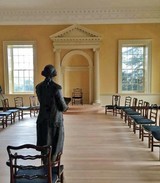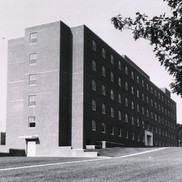America's 250th: Listening Session
As Maryland prepares to commemorate the 250th anniversary of the founding of the United States, MHT Director Elizabeth Hughes would like your feedback. How should we use cultural heritage to interpret these events? What themes should we highlight, and how can we be most inclusive in our storytelling? Please register for an upcoming listening session on April 29 or share feedback directly via this form.
|
|
 |
 |
|
FY2023 AAHPP Grants - Now Open
|
By Zachary Singer, MHT Research Archaeologist
April is Maryland Archeology Month! This year’s theme highlights innovative technologies in Maryland archaeology. Advances in technology have transformed how archaeologists study the past, allowing them to minimize excavations – an inherently destructive endeavor – and to gather more information from recovered artifacts.
Remote sensing technologies, such as magnetometry (which measures local deviations in the intensity of the Earth’s magnetic field) and ground-penetrating radar (which identifies subsurface conditions using electromagnetic pulses), help archaeologists detect potential archaeological sites before excavating. With the aid of GPS devices and GIS mapping software, these technologies can precisely determine the coordinates of potential archaeological resources, which archaeologists then pinpoint for examination through targeted excavation.
Archaeologists used remote sensing technologies to rediscover the location of the 17th century St. Mary’s Fort, which eluded researchers for nearly 100 years. Maps courtesy of Timothy Horsley, Horsley Archaeological Prospection.
Modern technologies have also enhanced archaeologists’ abilities to glean information from archaeological sites and artifacts. Improvements in radiometric dating techniques allow precise dating of sites, using samples as small as a single carbonized seed. X-ray fluorescence and X-ray diffraction permit archeologists to characterize the geochemistry and structure of soils, rocks, and ceramics to investigate site formation processes and link artifacts to raw material sources. Residue analysis techniques help identify preserved animal proteins and plant lipids on artifacts used to prepare food, allowing us to understand more about past diets. With digital X-radiography, archaeologists can penetrate corroded metals to reveal important characteristics of artifacts, including decorations, lettering, and maker’s marks. 3D modeling empowers archeologists to record and study artifacts and sites in digital formats, which helps protect fragile artifacts and assists in research and visualization.
 Conservators at the Maryland Archaeological Conservation Laboratory used X-radiography to determine whether this Civil War rifle, recovered from the site of the first Battle of Bull Run (Manassas, VA), was still loaded. Photo courtesy of Nichole Doub, MAC Lab.
Learn more about applications of innovative technologies in Maryland archaeology by visiting the Maryland Archeology Month website. You can also see these technologies in action by volunteering on archeology projects in the field and the lab, or by attending lectures, workshops, and site tours (opportunities are listed on the Calendar of Events). The website and events calendar will be updated as new events are announced, so be sure to visit often in April. Happy Maryland Archeology Month!
New Exhibit on Historic NIH Buildings
Through consultation with MHT under Section 106 of the National Historic Preservation Act, the National Institutes of Health created a new virtual exhibit for NIH Buildings 29 and 29A, hosted by the NIH Office of History and Stetten Museum. These historic buildings, vacant and proposed for demolition, will have a new legacy online.
|
|
 |
|